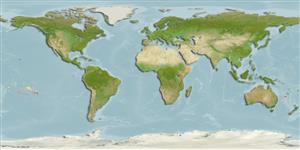Teleostei (teleosts) >
Acanthuriformes (Surgeonfishes) >
Pomacanthidae (Angelfishes)
Etymology: Centropyge: Greek, kentron = sting + Greek, pyge = tail (Ref. 45335).
More on authors: Randall & Caldwell.
Environment: milieu / climate zone / depth range / distribution range
Ecology
Marine; reef-associated; non-migratory; depth range 14 - 50 m (Ref. 48391). Subtropical
Eastern Pacific: Austral (including Rapa), Pitcairn and Easter islands.
Size / Weight / Age
Maturity: Lm ? range ? - ? cm
Max length : 10.0 cm TL male/unsexed; (Ref. 89972)
Found in areas with coral or rock bottoms and numerous crevices (Ref. 4858). Feeds on filamentous algae (Ref. 89972). Forms harems of 3-7 individuals. Rarely exported through the aquarium trade (Ref. 48391).
Life cycle and mating behavior
Maturity | Reproduction | Spawning | Eggs | Fecundity | Larvae
Pyle, R., 2001. Pomacanthidae: Angelfishes. p. 3266-3286. In K.E. Carpenter and V.H. Niem (eds.) FAO species identification guide for fishery purposes. The living marine resources of the Western Central Pacific. Volume 5. Bony fishes part 3 (Menidae to Pomacentridae). Rome, FAO. (Ref. 48391)
IUCN Red List Status (Ref. 130435: Version 2024-1)
Threat to humans
Harmless
Human uses
Fisheries: commercial; aquarium: commercial
Tools
Special reports
Download XML
Internet sources
Estimates based on models
Preferred temperature (Ref.
123201): 21.9 - 29, mean 27.4 °C (based on 180 cells).
Phylogenetic diversity index (Ref.
82804): PD
50 = 0.5000 [Uniqueness, from 0.5 = low to 2.0 = high].
Bayesian length-weight: a=0.03090 (0.01378 - 0.06932), b=2.88 (2.69 - 3.07), in cm total length, based on LWR estimates for this (Sub)family-body shape (Ref.
93245).
Trophic level (Ref.
69278): 2.8 ±0.3 se; based on size and trophs of closest relatives
Resilience (Ref.
120179): High, minimum population doubling time less than 15 months (Preliminary K or Fecundity.).
Fishing Vulnerability (Ref.
59153): Low vulnerability (10 of 100).
Nutrients (Ref.
124155): Calcium = 75.9 [30.0, 128.3] mg/100g; Iron = 0.766 [0.427, 1.470] mg/100g; Protein = 18.5 [17.2, 19.8] %; Omega3 = 0.17 [0.09, 0.32] g/100g; Selenium = 12.5 [5.4, 28.5] μg/100g; VitaminA = 55.8 [11.1, 251.5] μg/100g; Zinc = 1.39 [0.85, 2.33] mg/100g (wet weight);
